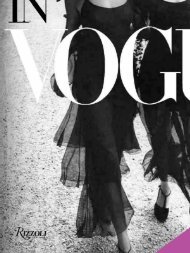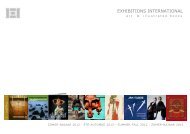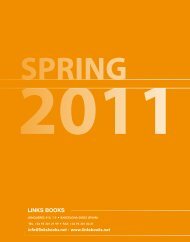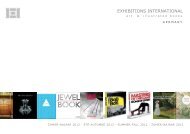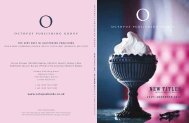DYNAMIC IDENTITIES How to create a living brand
DYNAMIC IDENTITIES How to create a living brand
DYNAMIC IDENTITIES How to create a living brand
Create successful ePaper yourself
Turn your PDF publications into a flip-book with our unique Google optimized e-Paper software.
The 6 components of an<br />
identity and its connections<br />
<strong>create</strong> the system. Variables<br />
<strong>create</strong> the dynamics, keeping<br />
a certain constant <strong>to</strong> maintain<br />
recognition.<br />
typo colour typo<br />
colour<br />
logo system language logo<br />
system<br />
language<br />
imagery graphic elements<br />
imagery<br />
logo<br />
Apple, for instance, fixes the logo (the<br />
apple), the colour (black and white), a font,<br />
and developed a unique language with the<br />
i-products (iPod, iPhone, iPad, …), creating a<br />
strong <strong>brand</strong>ing system. Levi’s and T-Mobile<br />
both claim a colour. You can recognise the red<br />
label on the side of the back pocket of a pair of<br />
Levi’s jeans without having <strong>to</strong> read the label.<br />
Each component helps sharpen the identity of<br />
the <strong>brand</strong> it represents. The more components<br />
are defined, the more specified the identity<br />
becomes. But within these limitations, there<br />
is definitely room for more freedom.<br />
Moving logos have been a trend lately. The<br />
restyles of UPC and Swisscom, for example,<br />
have resulted in an animated logo. <strong>How</strong>ever<br />
dynamic their new logos may seem, I see<br />
them as nothing more than a moving version<br />
of a static logo. Creating a dynamic identity<br />
requires much more freedom than just<br />
movement. For example, one or more of<br />
the components could consist of different<br />
variables, adding flexibility <strong>to</strong> the identity.<br />
Fixed components help the user recognise<br />
typo<br />
imagery<br />
system<br />
colour<br />
their <strong>brand</strong>; it is the variability that gives<br />
it room <strong>to</strong> live and evolve.<br />
Dynamic systems<br />
graphic elements<br />
Fixating at least one recognisable component<br />
can leave room <strong>to</strong> play with the others,<br />
creating a dynamic identity. This is nothing<br />
new. One of the first <strong>to</strong> take the leap was<br />
Manhattan Design, who <strong>create</strong>d an identity<br />
for MTV in 1981. They <strong>create</strong>d a system where<br />
‘M’ and ‘TV’ have a fixed shape and position,<br />
but can be built with thousands of variations<br />
of colours, patterns, textures, animations<br />
and illustrations. All of its iterations have only<br />
served <strong>to</strong> strengthen the youthful vibe that<br />
is synonymous with MTV. In 1994, Bruce Mau<br />
Design projected a fixed wordmark of the<br />
Netherlands Architecture Institute (NAi) on<strong>to</strong> a<br />
range of surfaces and materials, maintaining<br />
consistency while communicating the diverse<br />
activities and ambitions of the NAi. Today, this<br />
system of a container ‘holding’ content is still<br />
a common way <strong>to</strong> <strong>create</strong> a variable identity.<br />
A similar system is placing a wallpaper<br />
behind a fixed item. Wolff Olins <strong>create</strong>d this<br />
language<br />
graphic elements<br />
This book collects international<br />
examples of identities that are alive,<br />
meaning that they are not static<br />
but dynamic. That they can change<br />
and generate new versions over time,<br />
and behave like a <strong>living</strong> organism.<br />
I have categorised them in<strong>to</strong> 6<br />
different types of design systems,<br />
which I would like <strong>to</strong> call: Container,<br />
Wallpaper, DNA, Formula, Cus<strong>to</strong>mised<br />
and Generative. These names<br />
are based on their behaviour as<br />
described in the essay. This categorisation<br />
is of coarse not set in s<strong>to</strong>ne, as<br />
some could fall under more than one<br />
category, but should give the reader<br />
an overview of different ways <strong>to</strong><br />
<strong>create</strong> a dynamic identity.<br />
7


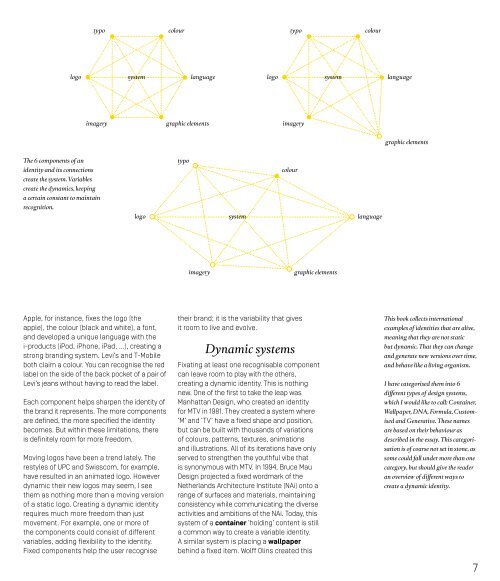
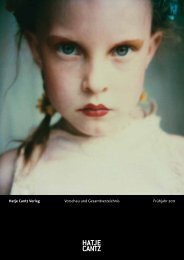
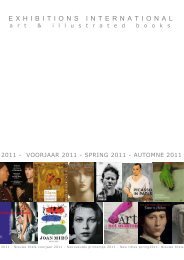

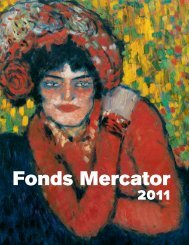
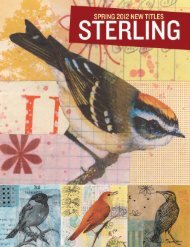

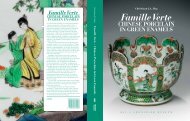
![01 -[BE/INT-2] 2 KOL +UITGEV+ - exhibitions international](https://img.yumpu.com/19621858/1/184x260/01-be-int-2-2-kol-uitgev-exhibitions-international.jpg?quality=85)

